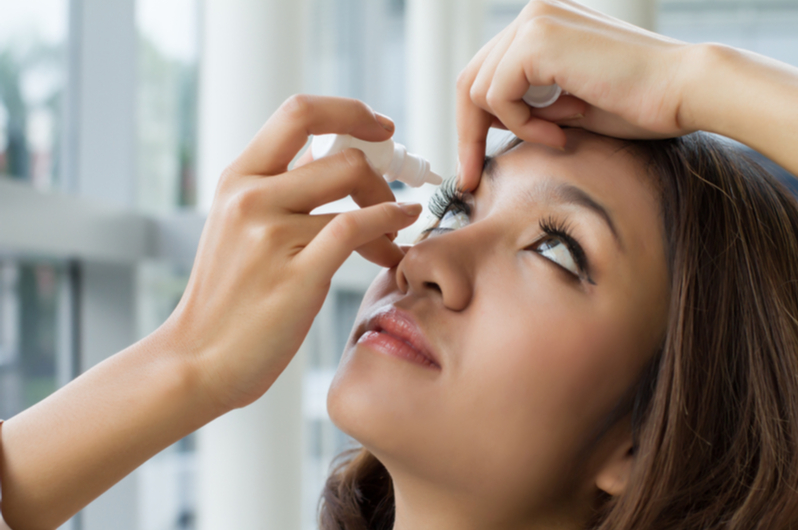Why Are My Eyes Dry? Dry Eye Options
Are you suffering from dry eyes? If you suffer from dry eyes, your symptoms are likely annoying and include itching, inflammation and burning of both eyes. This irritation is on the eye’s surface and can be very uncomfortable. Dry eyes may also cause eye fatigue, blurry vision and a sensitivity to light. But whether temporary or chronic, there are treatments for dry eyes that offer a great deal of relief depending on the cause.
Before the on-set of dry eyes you likely never thought about the perfect balance between lubrication, quality of tears and drainage. Your eyes had the seemingly easy task of providing your peepers with comfort and functionality with little help from you. But now your eyes cannot do all the work on their own and need your help. Part of that is finding the root of your dry eyes so you can take action on an effective treatment. You may be able to ascertain these answers on your own or enlist the help of an allergist, optometrist or ophthalmologist who can easily examine, diagnose, and treat your condition.
Causes of Dry Eyes
-
Environmental- Exposure to dust, smoke, heat/air-conditioning, dry climate or wind can cause dry eyes. Also, any activities that inhibit blinking, such as driving and excessive reading can contribute to eye dryness.
-
Medicinal side effects- Various medications can reduce your production of tears including: hypertension medications, antidepressants, pain medicines and antihistamines. This is caused by medications decreasing your aqueous
-
Allergies- The release of histamine causes eyes to itch and become inflamed with the main culprits being pollen and pet dander. In the case of allergies, your eyes will have dry eye symptoms as well as excessive tearing.
-
Aging & hormonal changes- Most seniors 55+ have some type of issue with dry eyes especially pregnant or menopausal women due to estrogen fluctuations.
-
Medical conditions- People with medical conditions (especially autoimmune issues) have increased likelihood of dry eyes, some of these include: arthritis, lupus, thyroid conditions, sarcoidosis, and diabetes due to their reduction of tears.
-
Corneal issues- Some causes of cornea damage can be caused by infections (bacterial, fungal & viral), injury and age. Sometimes the cornea is able to repair itself but other times medication or surgery is required.
Treatment for Dry Eyes
-
Tear Drops and Ointments- Most cases of dry eye can be treated using artificial tear drops which are available over the counter at most grocery stores and pharmacies. Artificial tear drops add similar lubricating components as natural tears. Thicker products such as ointments and gels can be used at home or bedtime, creating a protective layer over your eyes. Brands of artificial tears include Refresh Tears Lubricant Eye Drops, Systane Products, Thera Tears, Blink Tears and Genteal Tears.
-
Prescription Eye Drops- Similar to over the counter artificial tear drops, medicated drops such as Restasis and Xiidra are a prescription eye drop that lubricates the eye and reduces inflammation.
-
Steroidal Eye Drops- Eye drops for situations where regular prescription eye drops alone are not managing the inflammation. Steroidal eye drops are used temporarily and work quickly in conjunction with regular prescription eye drops.
-
Lacrisertis- This is a lubricant device placed under the eyelid for stubborn dry eye. Lacrisertis is generally used once a day and is recommended for people with severe dry eye where prescription eye drops are unsuccessful.
-
Temporary Punctal Occlusion- This procedure involves closing the punctum due to a drainage issue. If you have a temporary punctual occlusion than your treatment will consist of temporary plugs in the tear ducts that dissolve in a few days. If the temporary plugs solve the problem, your doctor will likely consider permanent plugs for you.
-
Meibomian Gland Expression (MGE)- A high percentage of dry eye cases are due to an insufficient amount of meibum (oil) being secreted from the meibomian glands. The openings of this gland get clogged and the gland is not able to get oil to the correct places creating meibomian gland dysfunction. To treat MGE, your doctor will squeeze the hardened contents of your gland with forceps to open the flow.
-
Lipiflow- Also called thermal pulsation, Lipiflow is used to treat MGD related evaporative dry eye. Your doctor will use a 12-minute heat and massage treatment, used to liquefy the meibomian gland’s hardened oil in an attempt to treat the lipid layer of the ocular surface.
-
Intense Pulsed Light (IPL)- Similar to a laser, IPL is a light therapy used to liquify the hardened oils clogging the meibomian glands using both simple and infrared light. The intense light energy used in IPL destroys ineffective blood vessels that contribute to the problem of dry eye. This is often used in conjunction with meibomian gland expression.
-
Scleral Contact Lenses- Large contact lenses that help trap moisture in the eyes by resting on the sclera (creating a tear filled reservoir over the cornea) keeping the eye moist. These lenses are a standard remedy for severe dry eyes.
